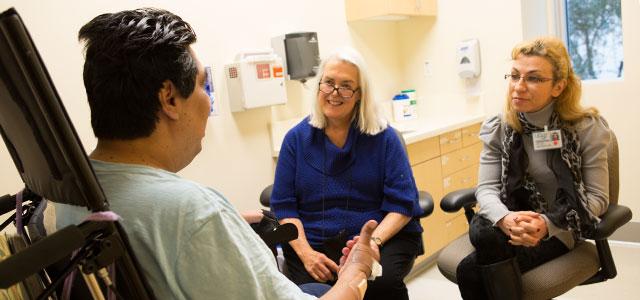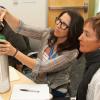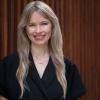
Anne Hughes (center) and student Julia Itsikson (right) consult with a patient at Laguna Honda Hospital and Rehabilitation Center in San Francisco (photo by Elisabeth Fall).
Palliative Care Minor Builds On Historic Commitment, Interdisciplinary Collaboration
Within months of beginning training in UC San Francisco School of Nursing’s Master’s Entry Program in Nursing (MEPN), Julia Itsikson observed a palliative care intervention for a middle-aged man with mesothelioma.
“The family was struggling to accept a devastating diagnosis and poor prognosis, but because of the palliative care team’s approach to this complicated and sensitive issue, both the patient and the family became more receptive to new goals of care that focused on comfort measures rather than aggressive treatment,” says Itsikson. “It got me interested.”
Now a student in the School’s recently established minor in palliative care, Itsikson joins a growing number of individuals, communities, policymakers and health care professionals calling for greater access to palliative care services – and more training for clinicians.
Beyond Hospice, Filling a Need
Palliative care assumes that patients who suffer from serious, life-limiting disease – not just those actively dying – need symptom relief and supportive care to ease the stress of coping with their illness. Multiple studies have shown that palliation can significantly improve patients’ quality of life – and, in some cases, prolong it.
Perhaps that’s why so many local hospitals and clinics urged the School to step up its palliative care training, says faculty member DorAnne Donesky, who led the School’s effort to establish its minor. She is among those who see the benefits of palliative care every day, in her clinical work with patients who have chronic pulmonary disease.
“The primary impetus for establishing the minor was local employers, including our own volunteer faculty, who expressed a strong need for palliative care-trained advanced practice nurses; many of the volunteer faculty even promised to reserve precepting time for our students,” says Donesky.
Expanding a Tradition of Palliative Care Training
Since 2002, when Professor Emerita Kathleen Puntillo established its first palliative care course, UCSF School of Nursing has been at the forefront of training advanced practice nurses to be part of palliative care teams. Often, the School has worked in concert with colleagues in medicine, social work and chaplaincy at UCSF Medical Center, which established one of the first inpatient palliative care units in California in 1999.
The curriculum in the new minor aims to match national competencies for palliative care and prepare students for the certification exam offered by the Hospice and Palliative Credentialing Center. To complete the minor, students take two base courses – including Puntillo’s original course, which Donesky now teaches – and an elective. In addition, Donesky helps place students in clinical settings with a palliative care mentor, thus helping the students accumulate the necessary 500 hours of practice for certification.
A Commitment to Interdisciplinary Training
“As part of the minor, we are committed to integrating learners across disciplines,” says Donesky, who co-directs the minor with UCSF palliative care physician Wendy Anderson. Those learners can include all the typical members of a palliative care team.
“The only way to provide high-quality palliative care is through an interdisciplinary approach, so taking advantage of the few opportunities for people to train together is very important,” says Anderson, who also co-directs a project with Puntillo and UCSF palliative care physician Steven Pantilat that helps bedside critical care nurses integrate palliative care into their day-to-day work.
The challenge is that interdisciplinary training often encounters large structural and logistical barriers, including having to calibrate the right place in each discipline’s educational process to integrate interprofessional education. Both Donesky and Anderson believe, however, that where there’s a will, there’s a way – and the will is there, largely because people attracted to palliative care tend to cherish collaboration with other disciplines.
“Physicians I work with are phenomenal about saying, ‘This is your expertise, this is mine,’ and we defer to each other where appropriate,” says Donesky.
 DorAnne Donesky (right) and respiratory therapist Brenda Gallegos (left) work with a patient, teaching her to exercise safely without overtaxing her lungs (photo by Elisabeth Fall). Thus, she and Anderson have drawn on their clinical experiences to create a curriculum for those times when they can bring the various disciplines together. They have created role-playing scenarios that include mixing and matching preceptors with students from other disciplines. They also will hold panels where the disciplines can frankly hash out their various roles, which sometimes overlap.
DorAnne Donesky (right) and respiratory therapist Brenda Gallegos (left) work with a patient, teaching her to exercise safely without overtaxing her lungs (photo by Elisabeth Fall). Thus, she and Anderson have drawn on their clinical experiences to create a curriculum for those times when they can bring the various disciplines together. They have created role-playing scenarios that include mixing and matching preceptors with students from other disciplines. They also will hold panels where the disciplines can frankly hash out their various roles, which sometimes overlap.
The lack of clarity around roles may be surprising, since the basic outlines are well established. Physicians do diagnosis, prognosis, treatment and management of complex medical conditions. Advanced practice nurses provide patient education, teach advanced self-management strategies for symptoms and monitor complex medical conditions. Bedside nurses coordinate care and listen carefully during family discussions, so they can reflect, reframe and return to comments that might have been lost. Chaplains provide spiritual succor for those coping with fear and loss. Social workers help families cope and adjust to illness both emotionally and practically.
Yet individual situations often confound any attempt to draw neat lines – and neat lines, says Anderson, are not always the ideal.
“Part of the reason our team at UCSF works so well together is that everyone has a certain degree of awareness and training in all the domains,” she says. “As a physician, this makes it easier to practice, because different disciplines view things through different lenses. It allows us to do a better job of taking care of patients and families, but also of each other, which is a key to sustainability.”
Ultimately, say both Donesky and Anderson, the training must also help team members look beyond guidelines about basic roles to understand individual strengths and weaknesses, so the teams can function at optimal levels.
“Team health is an evolving process, not just in palliative care, but also in critical care and many other disciplines,” says Anderson. “There’s a lot of emerging empiric work about collaboration and teamwork, and we’re drawing on that to build our curriculum.”
Focus on Communication
Among the most important aspects of both team health and palliative care is clear communication, which is the focus of the minor’s second required class.
“Employers have emphasized that they want nurses who have advanced training around difficult communications,” says Donesky. “We need to discuss the prognosis, negotiate family meetings or work with a surgeon who may have different goals of care than the nursing or medical staff. Often the nurse is the one who has the skills, interest and training to facilitate those conversations.”
Yet palliative care conversations pose unique challenges, so to help her prepare to teach the class, Donesky completed a course at Harvard that emphasizes teaching strategies for palliative care content and trained with VitalTalk, a program that emerged from National Institutes of Health (NIH)-funded research.
“Palliative care communication is improvisation,” she says. “We have to be completely present, aware of both spoken and unspoken communication as we respond to multiple people in the room – colleagues, patients and family members – all in an effective, therapeutic way.”
Hands-On Training
While role-playing and improvisation are crucial, there is no substitute for hands-on training, which is why Itsikson feels so privileged to have worked once a week through the fall and winter of 2014 with volunteer faculty member Anne Hughes, a PhD-prepared palliative care nurse at Laguna Honda Hospital and Rehabilitation Center.
“We primarily focused on team management, handling consultations about aggressive treatment or alternative treatments for pain, which can be quite challenging,” says Itsikson.
“We have a remarkable team here, and Julia has done a remarkable job jumping right in,” says Hughes. “But in a perfect world, nurses interested in palliative care would have a longer period of time in a clinical placement so they can witness how the needs of patients and families change over time.”
That said, Hughes is thrilled about the establishment of the minor and the opportunity to work with students motivated to adopt the specialty. In working with students, she says much of her focus is on how to be clear and compassionate in her communications. Mostly, that means listening deeply, but also not getting caught up in your own emotions or sadness, because it can get in the way of being available to support the patient and family in their grief.
“It’s incredible to watch Anne do her magic with families, who transform in front of my eyes just by how Anne says things and what she says, but I can see it’s easy to let it get to you emotionally,” says Itsikson. “People are grieving, and it inspires me how Anne always remains both compassionate and professional – that’s a really difficult balance.”
It’s also a continual learning process. “Keep learning,” Hughes advises. “Keep learning and witnessing amazing human experiences every single day.”
Looking Ahead
 Wendy Anderson Despite increased recognition of the need for more palliative care training, multiple challenges remain. For one, says Itsikson, “Not all patients and providers are willing to embrace it, because they view it as a synonym for hospice, failure, giving up, so there is a lot of work to be done.”
Wendy Anderson Despite increased recognition of the need for more palliative care training, multiple challenges remain. For one, says Itsikson, “Not all patients and providers are willing to embrace it, because they view it as a synonym for hospice, failure, giving up, so there is a lot of work to be done.”
“Palliative care is occurring across the continuum of health care; the opportunities to pursue it are endless,” says Hughes. “A lot of the work I do at Laguna is working with families who have a loved one with dementia, which we don’t automatically think of as an illness that requires palliative care, but it does because we can help figure out what brings joy and meaning to these patients’ lives and the lives of their families.”
Because of the expanding need, Donesky and Anderson see the establishment of the minor as the first step in a three-step process. Next steps are the creation of an interprofessional training center for practicing clinicians and a unique, interprofessional fellowship.
“This would not just be for advanced practice nurses, but also for chaplains, social workers, pharmacists – and physicians,” says Donesky.
UCSF already has a well-established fellowship for palliative care physicians, but it is a yearlong process aimed at those who want to make palliative care their specialty. Increasingly, though, the palliative care movement has begun to distinguish between primary and specialty palliative care, so in addition to having UCSF certify multiple disciplines in an interdisciplinary teaching environment, Donesky and Anderson envision a fellowship that would be available to physicians who want to be better prepared to deliver primary palliative care without making it the entire focus of their practice, such as an oncologist or primary care physician.
Donesky and Anderson also intend to make sure much of their work has an eye toward advancing palliative care research; Anderson already receives funding from the National Palliative Care Research Center.
“It’s visionary for a school of nursing to be thinking about interdisciplinary training,” says Anderson. “It’s so much where health care needs to be going, breaking down silos, but it takes an individual school and dean to make this a priority.”



